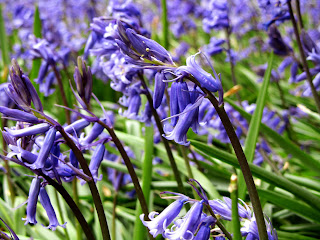This species is found in deciduous woodlands, hedgerows, meadows and on cliffs. The bluebell occurs in coppiced woodland, where it may dominate the ground flora. Humidity is a key requirement. It is intolerant of trampling, heavy grazing, water logging, deep shade and does not compete well with vigorous grasses. The presence of the species in hedgerows and under bracken on pastures may indicate that the land was once covered in woodland.
Although common in much of Britain and Ireland, Bluebell are rare in the rest of Europe and absent from the rest of the world. The populations in the UK represent about 30% of the global population. The species has greatly declined over the past 50 years and is globally threatened. Thus, native bluebells are protected in Northern Ireland through The Wildlife (Northern Ireland) Order 1985. It is illegal to collect seed or bulbs from the wild.
The reasons for the decline of the native Bluebell are:
- habitat loss, particularly woodland and hedgerows
- picking, uprooting and bulb removal, mainly for gardens
- tipping of garden waste in woodlands and hedgerows
- competition and hybridisation with its close relative the Spanish Bluebell
Bluebell (Hyacinthoides non-scripta) should not be confused with the non-native Spanish Bluebell (Hyacinthiodes hispanica). The Bluebell has fragrant flowers borne on one side of the stem. The anthers are cream-coloured and unequal and the raceme is nodding. The Spanish Bluebell has unscented flowers borne on all sides of the stem. It has blue, equal anthers and an erect raceme. The Spanish Bluebell is frequently planted in gardens and the two species hybridise with each other freely to create the fertile and backcrossing hybridHyacinthoides hispanica x non-scripta. Hybrid Bluebells are becoming widespread in the countryside – the result of pollination by bees and the dumping of unwanted bulbs beside the road. As the less-vigorous native Bluebell cannot compete successfully, its long-term survival is under threat.
Bluebell (Hyacinthoides non-scripta)
Spanish Bluebell (Hyacinthiodes hispanica)
Thank you
Abbi hughes.
All images copyright to Abbi Hughes, Information gained from - http://www.cvni.org/wildflowernursery/wildflowers/bluebell
Location : Ashridge, Church Road
Date: 20th April 2011
Time: 4pm - 5pm
Weather: Southerly warm and gentle winds, occasional cloud covor.
Map Reference: SP975135


No comments:
Post a Comment